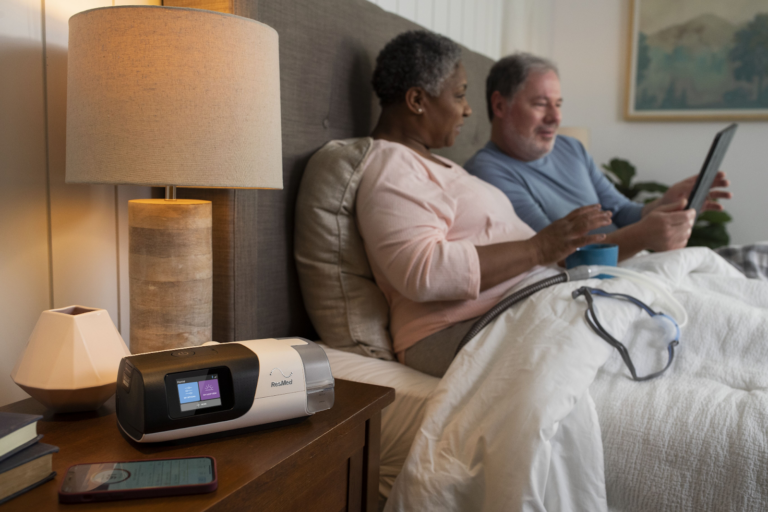Your cart is currently empty!
Prefer to just call? (07) 3472 6421
|
A Beginner’s Guide to CPAP Therapy: What to Expect in Your First 30 Days

The first nights on CPAP can be rough; the mask feels odd, the airflow takes getting used to, and sleep rarely comes easily. Almost everyone struggles in the beginning. The good news? Each night, you learn something new about comfort, fit, and what works best for your body.
This guide walks you through that first month: what typically happens, what problems to expect, and how to stay consistent until therapy feels natural.
At Sleep Warehouse, we’ve helped thousands of Australians settle into CPAP with fewer frustrations. The next few sections outline what makes those early nights easier to handle and how to start seeing results faster.
Before Your First Night: Setting Yourself Up for Comfort
The first step is to make the setup feel as natural as possible. You’ll sleep better once your equipment fits well, your environment feels right, and you know what to expect when you turn the machine on.
Choose the Right Mask and Fit
There’s no one-size-fits-all mask.
✔ Full-face masks suit mouth-breathers or people with congestion.
✔ Nasal masks feel lighter and work well if you mostly breathe through your nose.
✔ Nasal pillow masks are the least intrusive and help reduce that “closed-in” feeling.
Check the straps, cushion, and seal. A good fit means no pressure marks and no air leaks. If you need help, Sleep Warehouse can guide you through fit testing online or in-store; a small adjustment often changes everything.
Set Up Your Machine Correctly
Place the machine on a flat, stable surface close to your bed. Keep the hose untangled and free of bends.
If your model has a ramp feature, turn it on; it starts with lower pressure and increases gradually as you fall asleep. This small change makes the first few nights far more manageable.
Use the built-in humidifier if your throat or nose tends to dry out. Fill it with distilled water when possible to prevent mineral build-up.
Before bed, try the mask while sitting up for a few minutes. Breathe normally and get used to the airflow before lying down. It helps your body accept the pressure and reduces that “startled awake” feeling once you drift off.
Your First 30 Days: How the Adjustment Happens
Adapting to CPAP isn’t instant; it’s a short learning curve. Each week brings small but noticeable changes in how you sleep and how you feel during the day.
Week 1: Getting Used to the Routine
The first nights are about getting familiar with the gear. You might wake more often or notice dryness or slight irritation. That’s expected.
Keep sessions consistent; even short nights help your body adapt faster. If you wake and remove the mask, put it back on once you’re comfortable again.
Track your usage through your machine’s app or a simple sleep log. Seeing progress, even small improvements, keeps motivation up.
Week 2: Finding Your Comfort Zone
By the second week, you’ll start adjusting naturally. The pressure feels less noticeable, and your breathing settles into a rhythm. If leaks or noise interrupt sleep, check the mask seal or humidity settings.
If discomfort continues, Sleep Warehouse can review your setup and suggest minor adjustments. Most early issues come down to fit or airflow settings, not the machine itself.
Week 3: Noticing the Difference
This is when things begin to feel worthwhile. Mornings are clearer, headaches often ease, and energy levels rise. You may even start sleeping longer stretches without waking.
Keep using the machine nightly; skipping a session resets progress.
Week 4: Building Consistency
By the fourth week, CPAP becomes part of your normal routine. You’ll know when something feels off and how to fix it. The goal now is maintenance; keeping equipment clean and tracking your comfort as habits form.
If you’ve reached this point, you’ve already passed the hardest stage. From here, it’s about staying steady and letting the results keep you motivated.
Common Challenges and How to Fix Them
Everyone hits small hurdles when starting CPAP. Most problems are minor and easy to resolve once you know what’s causing them.
1. Dry Mouth or Nose
A dry mouth usually means air is escaping through slightly open lips or the humidity is too low.
✔ Try increasing humidifier levels or adding a heated hose.
✔ If you breathe through your mouth, consider a full-face mask or use a chin strap.
2. Air Leaks or Whistling Noises
Leaks are common early on. They usually mean the mask is too loose, too tight, or needs a cushion replacement.
✔ Readjust the straps while lying in your sleeping position.
✔ Replace cushions every few months or sooner if they feel stiff.
If leaks persist, Sleep Warehouse can help test fit and seal through a quick video call or in-store visit.
3. Pressure Feels Too Strong
If the airflow feels overwhelming, activate your machine’s ramp function so it starts low and increases slowly. Most people adjust within a few nights once this setting is tuned.
4. Claustrophobia or Restlessness
Start by wearing the mask for short periods while awake. Read, watch TV, or use your phone with it on until it feels less foreign.
Switching to a smaller nasal mask or nasal pillows can also make a big difference.
5. Mask Marks or Skin Irritation
Minor redness or marks are normal early on.
✔ Loosen the straps slightly.
✔ Use mask liners or soft silicone cushions.
✔ Keep the mask clean to prevent buildup that irritates skin.
Small adjustments add up. Once your setup fits comfortably, therapy runs smoothly without constant tinkering.
Benefits That Build Over Time
It’s easy to focus on the annoyances in the first few weeks. But consistent use delivers results that most people don’t expect; not just better sleep, but sharper days and a noticeable lift in mood and focus.
Better Energy and Focus
Within the first month, mornings start feeling lighter. You wake clearer, stay alert longer, and concentrate better. Tasks that used to feel heavy start to move quicker.
Health Improvements That Stick
Regular CPAP use helps lower blood pressure, supports heart health, and reduces the risk of complications linked to long-term sleep deprivation. Breathing steadily at night gives your body the recovery time it’s been missing.
Improved Relationships and Routine
Quieter nights mean your partner sleeps better, too. When fatigue fades, patience, productivity, and even motivation return naturally.
Confidence in Control
Once you see results, the machine stops feeling like a burden and becomes a safety net; something that lets you rest peacefully. And if you ever hit new issues, Sleep Warehouse is there to guide adjustments and keep therapy on track.
Managing Minor Side Effects
Most side effects from CPAP are short-term and easy to fix once you understand what’s causing them. The goal isn’t to power through discomfort, but to make small, practical changes that keep therapy consistent.
Nasal Dryness or Congestion
Low humidity or cool airflow can irritate the nasal passages.
✔ Increase the humidifier level or add a heated hose.
✔ Keep the room temperature moderate; cold, dry air worsens congestion.
✔ Use saline sprays if dryness persists.
Skin Imprints or Redness
Marks around the nose or cheeks usually mean the straps are too tight.
✔ Adjust the fit gradually instead of overtightening.
✔ Use mask liners or cushions to soften contact points.
✔ Replace worn parts regularly; old cushions lose flexibility and seal unevenly.
Aerophagia (Air Swallowing)
Some users feel bloated or gassy from swallowing air during sleep.
✔ Try lowering the pressure slightly under medical guidance.
✔ Avoid heavy meals before bed.
✔ Using the ramp feature also helps by letting your body ease into full airflow.
Mild Morning Fatigue
It’s common to feel slightly groggy in the first few weeks; your sleep cycles are resetting. Stay consistent and track usage; most users see improvement by the end of the first month.
If discomfort lasts or worsens, Sleep Warehouse can review your setup and guide adjustments remotely or in person.
Maintenance and Troubleshooting
CPAP therapy works best when the equipment stays clean and well-maintained. Routine care prevents performance drops, keeps the air fresh, and extends the life of your machine.
Daily and Weekly Care
✔ Every morning: Empty the humidifier chamber and let it air dry. Wipe the mask gently with a non-alcoholic cleaner.
✔ Weekly: Wash the tubing and mask in warm, soapy water and rinse thoroughly.
✔ Monthly: Replace disposable filters and inspect seals for cracks or stiffness.
Clean equipment not only prevents odour and bacteria but also reduces noise and airflow issues.
Replacing Components
Each part of your CPAP setup has a lifespan:
| Component | Replace Every |
| Mask cushion | 3–6 months |
| Filter | 1–2 months |
| Tubing | 6–12 months |
| Water chamber | 12 months |
When you order through Sleep Warehouse, we remind you when replacements are due and stock compatible parts for major ResMed models.
Simple Fixes for Common Problems
✔ Machine won’t power on: Check the plug connection or try another outlet.
✔ Pressure feels weak: Inspect filters for dust buildup.
✔ Unusual noise: Re-seat the mask and check for leaks or loose fittings.
✔ Water in the hose: Reduce humidity or use a heated tube to prevent condensation.
For persistent issues, our technicians can run a quick machine check to confirm whether it’s a simple part replacement or a service requirement.
Finally Sleeping Through the Night
The first month with CPAP isn’t smooth for anyone; it takes a few weeks to find your rhythm and learn what comfort actually feels like. Once you do, the difference is hard to miss. Mornings feel lighter, sleep feels deeper, and rest finally does what it’s meant to do.
By this point, your focus should shift from adjustment to consistency. Keep the gear clean, replace parts on schedule, and check in when something doesn’t feel right.
Sleep Warehouse helps you stay on track from fittings and filters to new devices when you’re ready. You’ve done the hard part; now it’s about keeping that good sleep going.
Stay consistent with your CPAP therapy; visit Sleep Warehouse today.
FAQs
1. How often should I replace my CPAP machine?
Most machines last around five years with proper care. You’ll know it’s time to upgrade if noise increases, air pressure drops, or data tracking stops working. Sleep Warehouse can assess your current model and recommend an upgrade only when it’s truly needed.
2. Can I use tap water in my humidifier?
Tap water works in a pinch, but minerals can build up over time and damage the chamber. Distilled water keeps the system cleaner and extends its lifespan. We stock travel-size distilled water packs and replacement chambers to make it easy to maintain good hygiene.
3. What if I can’t tolerate CPAP, even after trying adjustments?
Some users need alternative treatments like oral appliances or BiPAP systems. Speak with your sleep specialist before giving up; small setting changes often solve the issue. Our team can coordinate with your clinician to ensure your therapy stays on track.
4. How do I track my progress and know it’s working?
Most modern CPAP machines record usage hours, mask fit, and breathing data. Check your machine’s companion app or data card weekly. If you’re unsure how to read the results, Sleep Warehouse can walk you through the report and help interpret what’s improving.
ABOUT AUTHOR



Leave a Reply
You must be logged in to post a comment.